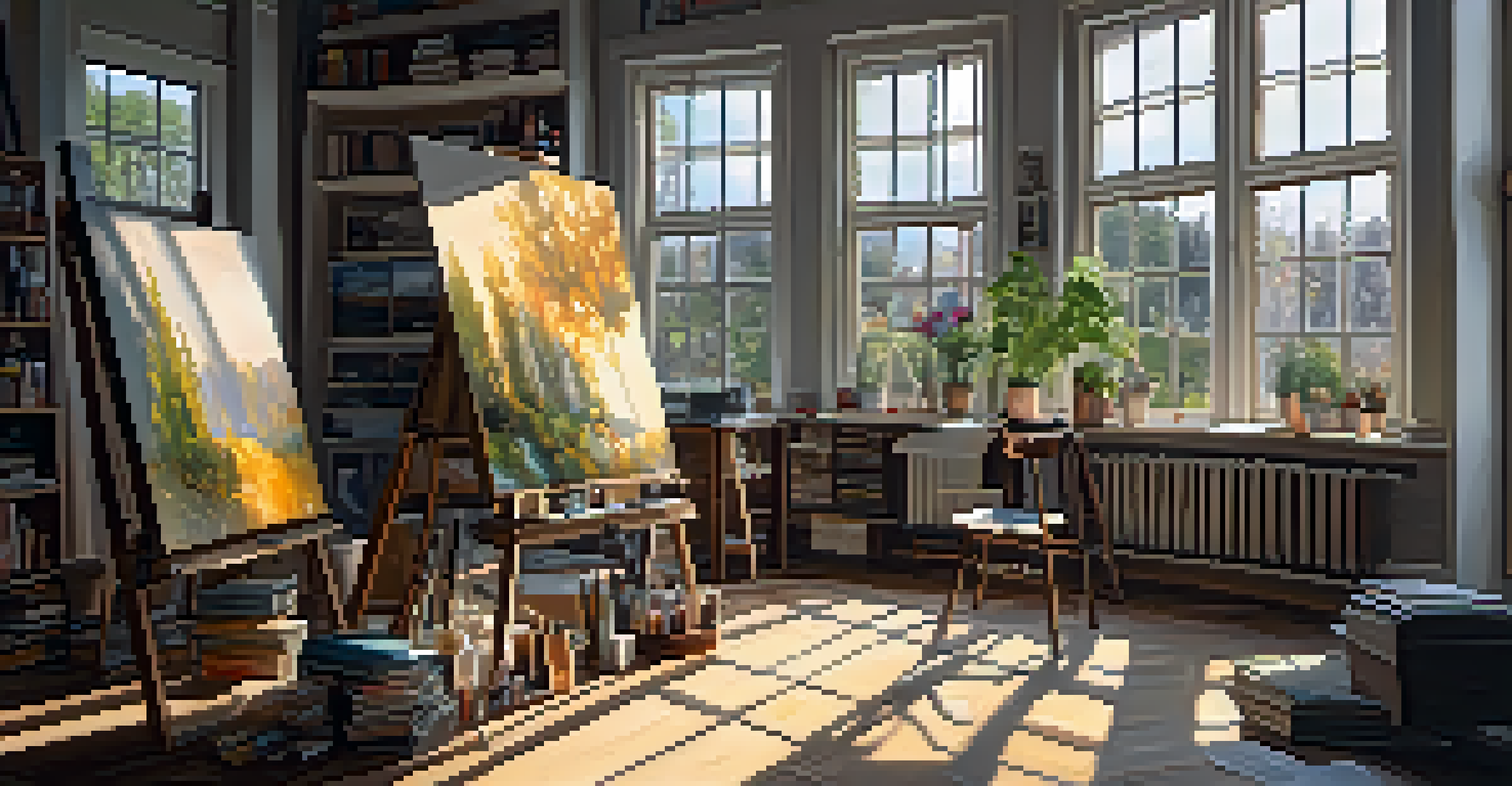The Influence of World Events on Global Art Movements

Historical Context: Art Reflects Society's Turmoil
Throughout history, art has served as a mirror to societal changes and conflicts. Events such as wars, revolutions, and social upheavals have inspired artists to depict the struggles and triumphs of their time. For instance, the aftermath of World War I birthed movements like Dada, which challenged traditional aesthetics in response to the absurdity of war.
Art is a reflection of the times, a mirror that shows us who we are and what we can become.
Similarly, the civil rights movement in the United States catalyzed the rise of African American artists who explored themes of identity and resistance. Artists like Jacob Lawrence captured the African American experience through vivid storytelling in their work. These historical contexts provide key insights into how external factors shape artistic expression.
As we delve deeper into specific art movements, we can see that the influence of world events often leads to a rich tapestry of creativity and commentary. Art becomes a powerful tool for reflection, allowing both artists and audiences to process their experiences during turbulent times.
The Role of Politics in Artistic Expression
Political climates can heavily influence art movements, as artists often respond to the ideologies and policies of their governments. For example, Soviet Realism emerged as a state-sponsored movement that aimed to promote communist ideals through art. This style glorified the everyday life of the working class, aligning with the political narrative of the time.

Conversely, many artists have also used their work to critique political regimes. The works of Francisco Goya, particularly during the Peninsular War, depict the horrors of conflict and the oppression of the people. Such art not only serves as a historical record but also as a form of resistance and advocacy for change.
Art as a Reflection of Society
Art has historically mirrored societal changes, responding to events like wars and civil rights movements to express the struggles and triumphs of the time.
This dynamic relationship between politics and art illustrates how artists can both reflect and challenge the status quo. The resulting dialogue can lead to new movements that redefine artistic boundaries while engaging with pressing political issues.
Economic Factors: Art as a Reflection of Wealth and Poverty
Economic conditions can significantly shape artistic movements, influencing both the themes artists explore and the mediums they choose. During economic downturns, such as the Great Depression, art often turns to themes of struggle and resilience. The American Regionalism movement is a prime example, focusing on rural American life and the hardships faced by everyday people.
Art must be an integral part of the social fabric, a way of understanding our lives and the world around us.
On the other hand, periods of economic prosperity can foster innovation and experimentation in art. The Roaring Twenties in the United States saw the rise of Art Deco, characterized by its luxurious materials and geometric designs, reflecting the era's wealth and optimism. Artists often find inspiration in the societal context created by these economic conditions.
This interplay between economics and art showcases how financial realities can dictate not just the content of art but also its accessibility and the resources available to artists. Understanding these factors helps us appreciate the broader societal narratives that art communicates.
Globalization: The Cross-Pollination of Cultures
In our increasingly interconnected world, globalization plays a pivotal role in shaping contemporary art movements. Artists today often blend various cultural influences, creating works that resonate on a global scale. For instance, the rise of street art has seen artists from different backgrounds sharing their messages across borders, making art more accessible and relevant to diverse audiences.
This cultural exchange can lead to the emergence of hybrid art forms, where traditional techniques meet modern themes. An example of this is the incorporation of indigenous motifs into contemporary practices, which not only honors cultural heritage but also revitalizes it for new generations. This blending of styles often sparks meaningful conversations about identity and belonging.
Politics Shape Artistic Expression
Political climates influence art movements, with artists often both reflecting and critiquing governmental ideologies through their work.
Globalization also raises questions about authenticity and appropriation in art. As artists navigate these complex dynamics, their work often reflects the challenges and triumphs of a global society, underscoring the importance of understanding the context in which art is created.
Technological Advances: New Mediums, New Messages
Technological advancements have always influenced art, from the invention of the camera to the rise of digital mediums. Today, artists leverage technology not only as a tool but also as a medium in itself. Digital art, virtual reality, and interactive installations challenge traditional notions of what art can be, inviting audiences to engage in novel ways.
For example, the use of social media platforms has enabled artists to reach wider audiences and foster community engagement. Artists like Banksy have utilized social media to amplify their messages and connect with fans globally, demonstrating the power of technology in contemporary art movements. These platforms also allow for immediate feedback and interaction, which can inspire new directions in an artist's work.
As we explore the impact of technology on art, it becomes clear that these innovations are not just changing how art is created but also how it is experienced. The evolving relationship between technology and art reflects the ongoing dialogue between innovation and tradition.
Cultural Movements: The Impact of Social Change on Art
Cultural movements often drive artistic change, as artists respond to shifts in societal values and norms. The feminist art movement, for example, emerged in the late 20th century, challenging patriarchal perspectives and advocating for women's rights. Artists like Judy Chicago and Cindy Sherman used their work to confront issues of gender and identity, reshaping the art landscape.
Similarly, the LGBTQ+ rights movement has influenced countless artists to explore themes of sexuality, identity, and representation. The works of Keith Haring and David Hockney, among others, reflect the struggles and triumphs of the queer community, highlighting the importance of visibility and acceptance in art.
Globalization Fuels Cultural Exchange
In an interconnected world, globalization fosters cultural blending in art, leading to hybrid forms that resonate with diverse audiences.
These cultural movements demonstrate how art can be a powerful vehicle for social change, giving voice to marginalized communities. By examining these connections, we can better understand the role of art in reflecting and shaping societal values.
The Future of Art: Anticipating Change in Global Movements
As we look to the future, it's essential to consider how ongoing global events will continue to shape art movements. From climate change to social justice issues, artists are increasingly using their platforms to advocate for change, creating works that challenge audiences to reflect on pressing issues. This proactive approach is likely to define the next wave of artistic expression.
Emerging technologies will also play a crucial role in the evolution of art. As virtual reality and augmented reality become more accessible, artists will likely explore these mediums to create immersive experiences that engage audiences in new ways. This could lead to the birth of entirely new movements that redefine how we understand and interact with art.

Ultimately, the future of art will remain intertwined with the fabric of global society. As world events unfold, we can expect artists to respond with creativity and insight, ensuring that art continues to be a powerful commentary on the human experience.